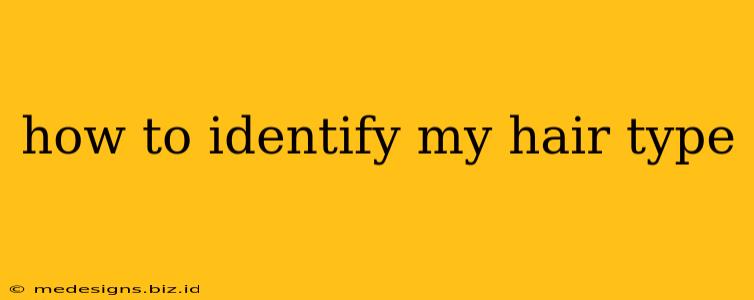Knowing your hair type is the first step to achieving healthy, beautiful hair. Understanding your hair's texture, porosity, and density allows you to choose the right products and styling techniques for optimal results. This comprehensive guide will walk you through the process of identifying your hair type, ensuring you're on the path to achieving your hair goals.
Understanding the Basics: Texture, Porosity, and Density
Before we delve into specific hair types, let's define three crucial characteristics:
1. Texture: Straight, Wavy, Curly, or Coily?
Hair texture refers to the shape of your hair strands. This is often categorized using a system that ranges from type 1 (straight) to type 4 (coily). Each type can further be divided into subtypes (a, b, c) based on the strand's curl pattern and thickness.
- Type 1: Straight Hair: Straight hair is typically sleek and shiny, with minimal volume. It can range from fine and limp to thick and coarse.
- Type 2: Wavy Hair: Wavy hair has an "S" shaped pattern with defined waves. It can be prone to frizz and may lack volume depending on the subtype.
- Type 3: Curly Hair: Curly hair forms distinct, well-defined curls. The curls can range in size, from loose waves to tight spirals.
- Type 4: Coily Hair: Coily hair is characterized by tightly packed, springy curls or coils. This hair type is usually very dry and prone to shrinkage.
To determine your hair texture, wash your hair and let it air dry without using any products. Observe the shape of your curls or waves. Pictures and online resources can be helpful in comparing your hair to the different types.
2. Porosity: How Well Does Your Hair Absorb Moisture?
Hair porosity refers to your hair's ability to absorb and retain moisture. There are three levels of porosity:
- Low Porosity: The hair cuticle is tightly sealed, making it difficult for moisture to penetrate. This can lead to product buildup and difficulty styling.
- Medium Porosity: The hair cuticle is slightly raised, allowing for moderate moisture absorption. This is generally considered the ideal porosity.
- High Porosity: The hair cuticle is raised and open, leading to rapid moisture absorption but also rapid moisture loss. This hair type tends to be very dry and prone to damage.
To test your porosity, perform the water test: Wash and condition your hair, then gently place a clean strand in a glass of water.
- Low porosity: The strand will barely sink or float.
- Medium porosity: The strand will sink slowly.
- High porosity: The strand will sink rapidly.
3. Density: How Many Hair Strands Do You Have?
Hair density refers to the number of hair strands per square inch on your scalp. There are three levels of density:
- Low Density: You can easily see your scalp through your hair.
- Medium Density: Your scalp is partially visible.
- High Density: Your scalp is completely covered with hair.
To determine your density, part your hair in several sections and examine your scalp.
Putting It All Together: Determining Your Complete Hair Type
Once you've determined your texture, porosity, and density, you can describe your hair type completely. For example, someone might have 2b medium porosity, medium density hair. This detailed information is crucial for selecting appropriate hair products and styling techniques that will cater to your specific needs.
Caring for Your Specific Hair Type
Once you know your hair type, you can begin to tailor your hair care routine accordingly. Remember to prioritize moisturizing if you have dry, high porosity hair, and focus on lightweight products if you have fine, low porosity hair.
Knowing your hair type is a journey of self-discovery and empowers you to make informed choices regarding your hair care routine. Don't be afraid to experiment and find what works best for you. Remember, consistency and patience are key to achieving your hair goals!
